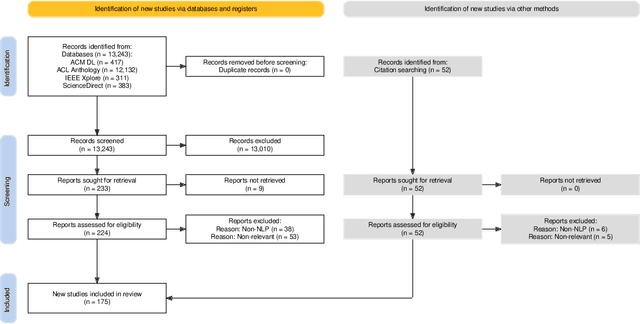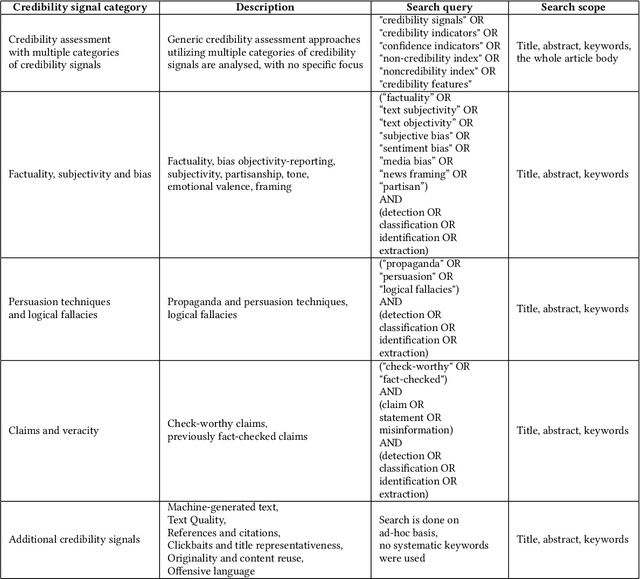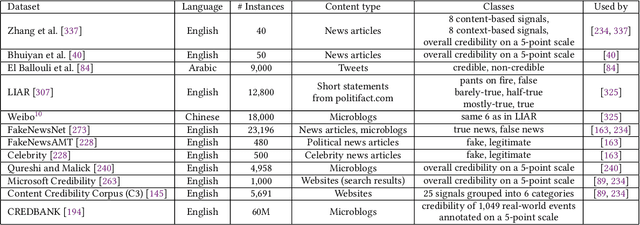Kalina Bontcheva
University of Sheffield
GateNLP at SemEval-2025 Task 10: Hierarchical Three-Step Prompting for Multilingual Narrative Classification
May 28, 2025Abstract:The proliferation of online news and the increasing spread of misinformation necessitate robust methods for automatic data analysis. Narrative classification is emerging as a important task, since identifying what is being said online is critical for fact-checkers, policy markers and other professionals working on information studies. This paper presents our approach to SemEval 2025 Task 10 Subtask 2, which aims to classify news articles into a pre-defined two-level taxonomy of main narratives and sub-narratives across multiple languages. We propose Hierarchical Three-Step Prompting (H3Prompt) for multilingual narrative classification. Our methodology follows a three-step Large Language Model (LLM) prompting strategy, where the model first categorises an article into one of two domains (Ukraine-Russia War or Climate Change), then identifies the most relevant main narratives, and finally assigns sub-narratives. Our approach secured the top position on the English test set among 28 competing teams worldwide. The code is available at https://github.com/GateNLP/H3Prompt.
UKElectionNarratives: A Dataset of Misleading Narratives Surrounding Recent UK General Elections
May 08, 2025Abstract:Misleading narratives play a crucial role in shaping public opinion during elections, as they can influence how voters perceive candidates and political parties. This entails the need to detect these narratives accurately. To address this, we introduce the first taxonomy of common misleading narratives that circulated during recent elections in Europe. Based on this taxonomy, we construct and analyse UKElectionNarratives: the first dataset of human-annotated misleading narratives which circulated during the UK General Elections in 2019 and 2024. We also benchmark Pre-trained and Large Language Models (focusing on GPT-4o), studying their effectiveness in detecting election-related misleading narratives. Finally, we discuss potential use cases and make recommendations for future research directions using the proposed codebook and dataset.
A Dataset for Analysing News Framing in Chinese Media
Mar 06, 2025Abstract:Framing is an essential device in news reporting, allowing the writer to influence public perceptions of current affairs. While there are existing automatic news framing detection datasets in various languages, none of them focus on news framing in the Chinese language which has complex character meanings and unique linguistic features. This study introduces the first Chinese News Framing dataset, to be used as either a stand-alone dataset or a supplementary resource to the SemEval-2023 task 3 dataset. We detail its creation and we run baseline experiments to highlight the need for such a dataset and create benchmarks for future research, providing results obtained through fine-tuning XLM-RoBERTa-Base and using GPT-4o in the zero-shot setting. We find that GPT-4o performs significantly worse than fine-tuned XLM-RoBERTa across all languages. For the Chinese language, we obtain an F1-micro (the performance metric for SemEval task 3, subtask 2) score of 0.719 using only samples from our Chinese News Framing dataset and a score of 0.753 when we augment the SemEval dataset with Chinese news framing samples. With positive news frame detection results, this dataset is a valuable resource for detecting news frames in the Chinese language and is a valuable supplement to the SemEval-2023 task 3 dataset.
A Cross-Domain Study of the Use of Persuasion Techniques in Online Disinformation
Dec 19, 2024Abstract:Disinformation, irrespective of domain or language, aims to deceive or manipulate public opinion, typically through employing advanced persuasion techniques. Qualitative and quantitative research on the weaponisation of persuasion techniques in disinformation has been mostly topic-specific (e.g., COVID-19) with limited cross-domain studies, resulting in a lack of comprehensive understanding of these strategies. This study employs a state-of-the-art persuasion technique classifier to conduct a large-scale, multi-domain analysis of the role of 16 persuasion techniques in disinformation narratives. It shows how different persuasion techniques are employed disproportionately in different disinformation domains. We also include a detailed case study on climate change disinformation, highlighting how linguistic, psychological, and cultural factors shape the adaptation of persuasion strategies to fit unique thematic contexts.
Hostility Detection in UK Politics: A Dataset on Online Abuse Targeting MPs
Dec 05, 2024Abstract:Numerous politicians use social media platforms, particularly X, to engage with their constituents. This interaction allows constituents to pose questions and offer feedback but also exposes politicians to a barrage of hostile responses, especially given the anonymity afforded by social media. They are typically targeted in relation to their governmental role, but the comments also tend to attack their personal identity. This can discredit politicians and reduce public trust in the government. It can also incite anger and disrespect, leading to offline harm and violence. While numerous models exist for detecting hostility in general, they lack the specificity required for political contexts. Furthermore, addressing hostility towards politicians demands tailored approaches due to the distinct language and issues inherent to each country (e.g., Brexit for the UK). To bridge this gap, we construct a dataset of 3,320 English tweets spanning a two-year period manually annotated for hostility towards UK MPs. Our dataset also captures the targeted identity characteristics (race, gender, religion, none) in hostile tweets. We perform linguistic and topical analyses to delve into the unique content of the UK political data. Finally, we evaluate the performance of pre-trained language models and large language models on binary hostility detection and multi-class targeted identity type classification tasks. Our study offers valuable data and insights for future research on the prevalence and nature of politics-related hostility specific to the UK.
A Survey on Automatic Credibility Assessment of Textual Credibility Signals in the Era of Large Language Models
Oct 28, 2024



Abstract:In the current era of social media and generative AI, an ability to automatically assess the credibility of online social media content is of tremendous importance. Credibility assessment is fundamentally based on aggregating credibility signals, which refer to small units of information, such as content factuality, bias, or a presence of persuasion techniques, into an overall credibility score. Credibility signals provide a more granular, more easily explainable and widely utilizable information in contrast to currently predominant fake news detection, which utilizes various (mostly latent) features. A growing body of research on automatic credibility assessment and detection of credibility signals can be characterized as highly fragmented and lacking mutual interconnections. This issue is even more prominent due to a lack of an up-to-date overview of research works on automatic credibility assessment. In this survey, we provide such systematic and comprehensive literature review of 175 research papers while focusing on textual credibility signals and Natural Language Processing (NLP), which undergoes a significant advancement due to Large Language Models (LLMs). While positioning the NLP research into the context of other multidisciplinary research works, we tackle with approaches for credibility assessment as well as with 9 categories of credibility signals (we provide a thorough analysis for 3 of them, namely: 1) factuality, subjectivity and bias, 2) persuasion techniques and logical fallacies, and 3) claims and veracity). Following the description of the existing methods, datasets and tools, we identify future challenges and opportunities, while paying a specific attention to recent rapid development of generative AI.
EUvsDisinfo: a Dataset for Multilingual Detection of Pro-Kremlin Disinformation in News Articles
Jun 18, 2024



Abstract:This work introduces EUvsDisinfo, a multilingual dataset of trustworthy and disinformation articles related to pro-Kremlin themes. It is sourced directly from the debunk articles written by experts leading the EUvsDisinfo project. Our dataset is the largest to-date resource in terms of the overall number of articles and distinct languages. It also provides the largest topical and temporal coverage. Using this dataset, we investigate the dissemination of pro-Kremlin disinformation across different languages, uncovering language-specific patterns targeting specific disinformation topics. We further analyse the evolution of topic distribution over an eight-year period, noting a significant surge in disinformation content before the full-scale invasion of Ukraine in 2022. Lastly, we demonstrate the dataset's applicability in training models to effectively distinguish between disinformation and trustworthy content in multilingual settings.
Addressing Topic Granularity and Hallucination in Large Language Models for Topic Modelling
May 01, 2024



Abstract:Large language models (LLMs) with their strong zero-shot topic extraction capabilities offer an alternative to probabilistic topic modelling and closed-set topic classification approaches. As zero-shot topic extractors, LLMs are expected to understand human instructions to generate relevant and non-hallucinated topics based on the given documents. However, LLM-based topic modelling approaches often face difficulties in generating topics with adherence to granularity as specified in human instructions, often resulting in many near-duplicate topics. Furthermore, methods for addressing hallucinated topics generated by LLMs have not yet been investigated. In this paper, we focus on addressing the issues of topic granularity and hallucinations for better LLM-based topic modelling. To this end, we introduce a novel approach that leverages Direct Preference Optimisation (DPO) to fine-tune open-source LLMs, such as Mistral-7B. Our approach does not rely on traditional human annotation to rank preferred answers but employs a reconstruction pipeline to modify raw topics generated by LLMs, thus enabling a fast and efficient training and inference framework. Comparative experiments show that our fine-tuning approach not only significantly improves the LLM's capability to produce more coherent, relevant, and precise topics, but also reduces the number of hallucinated topics.
Large Language Models Offer an Alternative to the Traditional Approach of Topic Modelling
Mar 26, 2024Abstract:Topic modelling, as a well-established unsupervised technique, has found extensive use in automatically detecting significant topics within a corpus of documents. However, classic topic modelling approaches (e.g., LDA) have certain drawbacks, such as the lack of semantic understanding and the presence of overlapping topics. In this work, we investigate the untapped potential of large language models (LLMs) as an alternative for uncovering the underlying topics within extensive text corpora. To this end, we introduce a framework that prompts LLMs to generate topics from a given set of documents and establish evaluation protocols to assess the clustering efficacy of LLMs. Our findings indicate that LLMs with appropriate prompts can stand out as a viable alternative, capable of generating relevant topic titles and adhering to human guidelines to refine and merge topics. Through in-depth experiments and evaluation, we summarise the advantages and constraints of employing LLMs in topic extraction.
Lying Blindly: Bypassing ChatGPT's Safeguards to Generate Hard-to-Detect Disinformation Claims at Scale
Feb 13, 2024Abstract:As Large Language Models (LLMs) become more proficient, their misuse in large-scale viral disinformation campaigns is a growing concern. This study explores the capability of ChatGPT to generate unconditioned claims about the war in Ukraine, an event beyond its knowledge cutoff, and evaluates whether such claims can be differentiated by human readers and automated tools from human-written ones. We compare war-related claims from ClaimReview, authored by IFCN-registered fact-checkers, and similar short-form content generated by ChatGPT. We demonstrate that ChatGPT can produce realistic, target-specific disinformation cheaply, fast, and at scale, and that these claims cannot be reliably distinguished by humans or existing automated tools.
 Add to Chrome
Add to Chrome Add to Firefox
Add to Firefox Add to Edge
Add to Edge